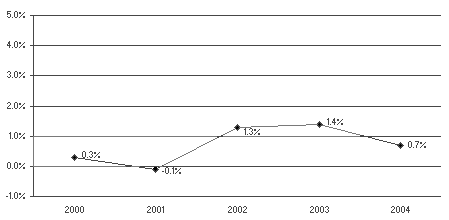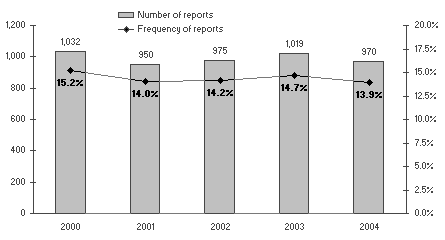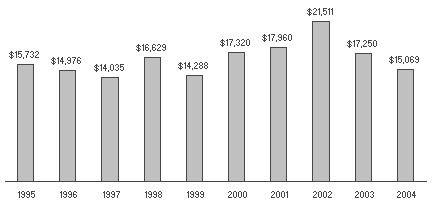This Insurance Issues:
- reports on the 2005 compulsory program and policy;
- reviews statistics on claims and potential claims within the program;
- introduces new risk management resources;
- reviews insurance coverage advice available on the website, including information about insurance coverage for lawyers no longer in private practice.
The Lawyers Insurance Fund manages the Law Society’s insurance program for BC lawyers. The program provides:
- professional liability insurance to protect lawyers if they are liable for negligence and to ensure that clients receive compensation to which they are entitled (Part A of the policy); and
- trust protection coverage to ensure that innocent members of the public do not suffer a financial loss through theft by a BC lawyer (Part B of the policy).
Assessment
For the sixth consecutive year, the Benchers have set the annual insurance assessment at $1,500, the lowest premium since 1986. Although longstanding stability in the program and effective management by the Lawyers Insurance Fund currently support this level of assessment, continued sustainability of the premium will depend, in part, on the level of the Fund surplus above the stipulated reserve for contingencies.
Compulsory policy wording
In May, 2004, the first consolidated policy issued since 2000:
- incorporated wording changes to the coverage for negligence (Part A) made by endorsement since the last consolidated policy, and included some minor revisions; and
- introduced new “trust protection” coverage for theft (Part B).
For 2005, the consolidated policy is renewed, with some minor wording changes.
General
Several changes were necessary to reinstate the aggregate limits, pro-rated in the May, 2004 policy because the policy was issued mid-year. The Part A annual aggregate limits of $2 million per error are available in full, as is the Part B profession-wide aggregate limit of $17.5 million.
Part B
These changes simply clarify the intent of certain provisions. The changes are as follows:
- those portions of Exclusions 6.1 and 6.2 that relate to Part B coverage are amended;
- a new provision is added to Condition 3.3 dealing specifically with the obligation of other insureds to reimburse the insurer;
- Condition 5.4 is amended by including Law Society insurers as parties to whom information may be disclosed.
A copy of the 2005 renewal endorsement is enclosed in this mailing. The May, 2004 consolidated policy, as well as the 2000 consolidated policy and subsequent endorsements, are available in the Lawyers Insurance Fund section of the Law Society website.
Coverage under the 2005 compulsory policy
Part A
The program limits of coverage remain unchanged, and continue to provide each insured lawyer with $1 million of coverage for each error, to an annual maximum of $2 million for all errors reported during the year. The deductible remains at $5,000 for a paid claim, increasing to $10,000 for each subsequent paid claim reported within three years. Lawyers can also increase the limits of their coverage by purchasing excess insurance privately.
Part B
The program continues to provide a profession-wide aggregate limit of $17.5 million, with no deductible, for Law Society members. There is no other limit per lawyer, claim, error or claimant.
A review of claim and potential claim reports
Stability continues to be the hallmark of the program, as illustrated by the charts on page 3. 2004 saw little change in the number of insured lawyers, and a slight reduction in the number of reports. Although the average cost of claims dropped again in 2004, changes over the past 10 years remain gradual, suggesting that significant developments are unlikely. The average cost of claims is based on actuarial estimates that tend to decrease as time passes.
The chart Percentage growth in insured lawyers shows the percentage growth over the past five years. Insured lawyers include both full and part-time lawyers.
Percentage growth in insured lawyers

The chart Number and frequency of reports shows the number of reports and the frequency of reports (reports divided by insured lawyers) over the past five years.
Number and frequency of reports

The chart Average cost of claims shows the average cost per report over the last 10 years, based on the actuary’s estimate of expected losses.
Average cost of claims

Lawyers Insurance Fund service exemplary
In 2000, the Lawyers Insurance Fund began formally seeking feedback from insured lawyers on the services provided both by in-house Claims Counsel and defence counsel. As each file is closed, a service evaluation form is sent out to the insured lawyer, asking that lawyer to rate his or her satisfaction on a scale of 1 (“not at all”) to 5 (“a lot”) in a number of areas relating to our performance. We also ask specifically for comments, both positive (“kudos”) and negative (“grumbles”), regarding the services provided.
The return rate is excellent (almost 60%), and BC lawyers continue to express high satisfaction overall with these services. In 2004, 90% of survey respondents gave a high approval rating (4 or 5 on a scale of 1 to 5) on the services provided by defence counsel, 92% on the outcome of their claims, 95% on the handling of their claims and 96% on the services provided by LIF Claims Counsel.
|
2004 service evaluation by insured lawyers
|
| |
Not at all A lot
|
| |
1
|
2
|
3
|
4
|
5
|
|
How satisfied overall were you with the services provided by defence counsel?
|
0%
|
0%
|
10%
|
17%
|
73%
|
|
How satisfied overall were you with the outcome of your claim?
|
1%
|
1%
|
6%
|
20%
|
72%
|
|
How satisfied overall were you with the handling of your claim?
|
1%
|
1%
|
5%
|
27%
|
68%
|
|
How satisfied overall were you with the services provided by Claims Counsel?
|
1%
|
0%
|
4%
|
22%
|
74%
|
The service evaluation forms can yield valuable information that assist the Lawyers Insurance Fund in planning improvements in service. Whenever an insured lawyer has a negative comment, we follow up to determine how best to address the concern expressed.
Proactive claims management: highlight on repairs
One of the best resolutions of a claim or potential claim is a successful repair, which is achieved in approximately 12% of all matters reported. A repair eliminates or significantly reduces the potential damages from an error. The client is restored to his or her original position, the lawyer who made the mistake is generally able to resume acting and the solicitor-client relationship is salvaged.
The majority of repairs are quarterbacked by LIF Claims Counsel. The following example illustrates how proactive claims management in effecting repairs virtually eliminated negative consequences to the Fund (and lawyers) from one mistake. The technical requirement of the Builders Lien Act to commence an action in the correct registry is a trap that catches a number of lawyers. Several years ago, five lawyers started separate actions to enforce five builders’ lien claims, all in the wrong registry. The actions were arguably nullities, and the liens were discharged.
Lawyers Insurance Fund Claims Counsel coordinated a repair to persuade the court to exercise its discretion to transfer the actions to the appropriate registry and preserve the claims of lien. The orders were granted, although without any written reasons. Recently, when another lawyer reported the same mistake, Claims Counsel orchestrated a successful repair by providing the insured lawyer with copies of the earlier orders and supporting materials, and instructing counsel to seek written reasons.
With these reasons in hand, lawyers facing a similar predicament in the future will easily convince opposing counsel that the application to remedy the error will succeed and ought not to be opposed. As any costs incurred in a contested application are first paid out of the lawyer’s deductible, the lawyer’s own pocketbook (as well as the insurer’s) is protected.
Risk management
New cause of loss reports
The Lawyers Insurance Fund has recently developed reports that track the underlying causes of claims, using a system introduced in 2000. In addition, a section recently added to the service evaluation form (titled “risk management comments”) allows the program to obtain the insured lawyer’s view on what caused the claim or potential claim and how other lawyers might avoid being caught in a similar situation. The reports provide more meaningful data than is generally kept by insurers tracking the causes of claims and, in conjunction with the anecdotal information received from the revised form, will assist in risk management activities.
New risk management publication
The Lawyers Insurance Fund will soon introduce a new risk management publication — Insurance Issues: Risk Management. The publication will draw from the Fund’s claims experience to offer advice on practices and areas that present potential risks to lawyers. The new circular will complement the Alert!bulletin, which alerts the profession to critical issues that present immediate risk to lawyers. Please stay tuned.
Coverage questions and website answers
Although the compulsory policy provides broad coverage for lawyers’ errors and omissions, lawyers may wonder whether an activity or practice in certain circumstances is covered by the insurance policy. Answers to some of the more commonly asked questions are available on the LIF portion of the Law Society website. The following excerpt is from the website answer to the question: Am I still covered by the compulsory insurance policy if I am no longer in private practice?:
"Insurance coverage for lawyers no longer in private practice
Lawyers leave private practice for various reasons: retirement, an appointment to the Bench, moving in-house with a company. However, negligence claims that arise from legal services provided while the lawyer was still practising and insured, may not surface for the first time until after that lawyer has left private practice. To respond to such claims, the Law Society’s compulsory professional liability insurance policy provides built in “tail” or “discovery” coverage to all BC insured lawyers at no additional cost. Not every law society in Canada provides this additional coverage free of charge to its lawyers, and the commercial market always charges a significant premium.
As long as the lawyer purchased the policy at the time the services giving rise to the error were provided (as all lawyers in private practice must), that lawyer will have coverage under the policy in effect at the time the error is discovered and reported to the Lawyers Insurance Fund. As a result, once a lawyer leaves private practice and stops paying the annual insurance fee for any reason, as long as that lawyer paid the insurance fee at the time the services giving rise to the error were provided, he or she will always be eligible for cover under subsequent policies."
The website also provides information on coverage enquires relating to the policy’s business and benefit exclusion and insurance coverage for pro bono services.
If you have other questions, feel free to contact any one of the following “advance ruling” advisors with your enquiries: Margrett George, Program Administrator, at 604 443-5761 and email to mgeorge@lsbc.org, Lenore Rowntree at 604 605-5314 and email to lrowntree@lsbc.org or Chris Bolan at 604 605-5349 and email to cbolan@lsbc.org.
2005 and beyond
The profession as a whole can have confidence in the Lawyers Insurance Fund’s ability to effectively manage claims. However, the Fund continues to pay out between $10 million and $11 million in negligence claims and defence costs each year. Careful practice and effective risk management remain the most effective means of ensuring continued stability in both the program’s costs and your annual insurance fee.